The Diplomat
The Governments of Spain and Panama have signed an agreement to cooperate in the investigation, management, research, protection, conservation and preservation of underwater cultural heritage resources and sites.
The Memorandum of Understanding (MoU) was signed in Panama City on March 3 by the Spanish Ambassador to Panama, Guzmán Palacios Fernández, representing the Ministry of Culture and Sports, and the Panamanian Minister of Culture, Giselle González Villauré, in the presence of Panama’s Vice Minister of Multilateral Affairs and International Cooperation, Yill Otero, as witness of honor. The signing took place in the margins of the conference Our Ocean. The European Commissioner for the Environment, Oceans and Fisheries, Virginijus Sinkevicius, the U.S. Special Presidential Climate Envoy, John Kerry, and numerous ministers or deputy ministers of foreign affairs and the environment, among others, attended the event.
The MoU allows the establishment of a formal instrument of joint cooperation between the two countries in relation to underwater cultural heritage, according to the Spanish government. Both Panama and Spain are States Parties to the UNESCO Convention on the Protection of the Underwater Cultural Heritage (adopted in Paris on November 2, 2001). Panama was the first country to deposit its instrument of ratification, in May 2003, while Spain did so in June 2005.
The cooperation framework established may include exchanges of historical, archaeological and technical information, participation in seminars, conferences, training courses and workshops, and the availability of personnel, specialists, advisors and other resources for programs or projects.
In addition, both parties undertake to prevent spoliation in their respective waters and to take the necessary control measures to prevent the entry into their territory, trade and possession of spoliated or illicitly recovered underwater cultural heritage. Likewise, they shall exchange and share information regarding underwater cultural heritage elements and sites of archaeological and historical interest to any of the signatories, in order to propose necessary lines of research. Such exchange of information will respect the confidentiality due under the laws of both signatory States.
Both authorities will also cooperate in the preparation and dissemination of reports, public education and other interpretive materials and other outreach activities to make information available to the public. They will also propose lines of research to carry out archaeological examination and survey activities in a manner consistent with the international standards set forth in the Rules of the Annex to the UNESCO Convention on the Protection of the Underwater Cultural Heritage. The two Ministries will also cooperate with third parties within the Republic of Panama, such as the Patronato de Panama Viejo or similar institutions, in order to energize and promote existing projects in the field.
San José Galleon
Among the specific projects mentioned in the memorandum is the wreck of the Galleon San José, a mighty ship of the Spanish Crown submerged off the coast of Panama (not to be confused with the galleon of the same name wrecked in Cartagena de Indias, whose remains are disputed between Spain and Colombia), as well as other remains that the Panamanian Ministry of Culture may have identified.
The 400-ton galleon San José, built in Guayaquil, was part of the Armadilla de la Mar del Sur and wrecked in 1631 in the archipelago of Las Perlas when it was transporting a large cargo of silver from El Callao to Panama. According to historian Alfredo Castillero Calvo, its shipwreck was the greatest loss in monetary terms that occurred in Panamanian waters during the colonial period, hence the interest it has aroused among treasure hunters and the importance of its protection and proper investigation under the control of the respective authorities and under the protection of the UNESCO Convention.
For the purpose of communication between the two Ministries, the National Directorate of Cultural Heritage in Panama and the General Directorate of Cultural Heritage and Fine Arts in Spain have been designated as points of contact.






